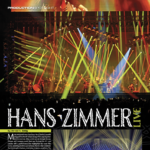
As a famous guitarist once sang, all things must pass. Phil Collins, who at 19 played congas on the George Harrison album of the same name, knows this only too well. A shadow of his former bouncy self, debilitating nerve damage now sadly forces him to perform seated while his 21-year-old son, Nic, skillfully reproduces the flamboyant drum parts with all the dexterity of his father. It’s heartbreaking but despite his limitations, Collins’ humor remains intact, and he deserves enormous respect for agreeing to take to the road one more time with the band that made his name.
For the first time since 2007’s Turn it on Again tour, Genesis is back with The Last Domino? as they play out their final chapter under the show directorship of Patrick Woodroffe, co-founder of the ever-visionary Woodroffe Bassett Design (WBD).
A reminder of past glory is evident as Genesis opens the show with “Duke’s Intro.” Bathed in white light, the stage at first resembles the cover of classic live album Seconds Out, but it’s hardly business as usual. Treading the boards with mainstay principals Tony Banks (keyboards) and Mike Rutherford (guitars and bass), and touring regular Daryl Stuermer (guitars and bass), are backing vocalists Daniel Pearce and Patrick Smyth who provide strong support for Collins and help give the band a more contemporary edge.
Familiar names lead the team on the road. Steve “Pud” Jones and Howard Hopkins have returned to fulfill the TM and PM roles, aided in their mission by head rigger Steve Armstrong and Stage Manager Ian “Robbo” Robertson, while Wonder Works’ Jeremy Lloyd reprises his technical integration and design consultancy position.
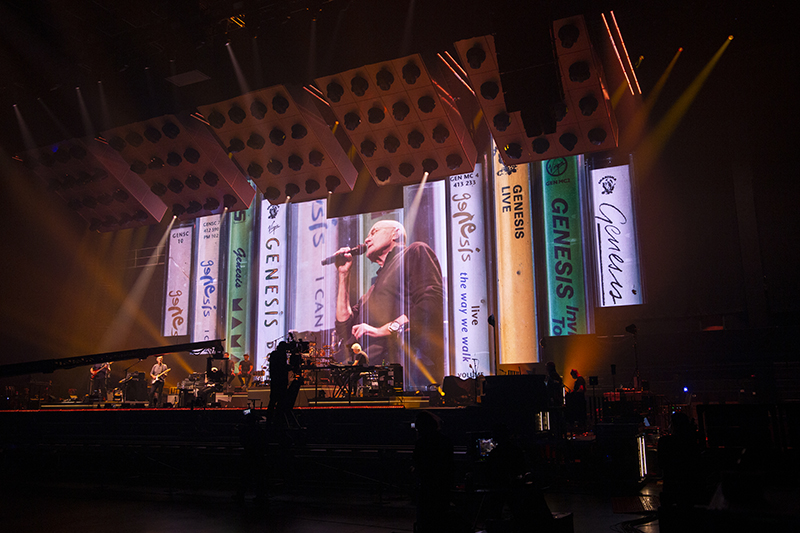
Woodroffe collaborated on the lighting design with Roland Greil, the Munich-based professional who has been associated with WBD for more than 15 years on projects for The Rolling Stones, Adele, Rammstein, and Phil Collins, whose last solo tour was nearing its end when Woodroffe was first approached about the Genesis reunion by longtime band manager, Tony Smith.
“We were on the final U.S. leg with Phil in the fall of 2019 when we were given a heads-up,” recalls Greil, who pilots the show from an MA Lighting grandMA2 full-size console. “And so, the game of creative ping-pong began as we debated the best approaches to what was always going to be a big, theatrical production, with a large number of different lighting scenes giving each song a bespoke visual identity. This is a seminal British prog outfit that went on to achieve regular pop chart hits, so we were mindful of representing that diverse journey. A large portion of their set focuses on when they were at their most commercial, but they are balanced by some major reminders of the ‘70s [Peter] Gabriel era.”
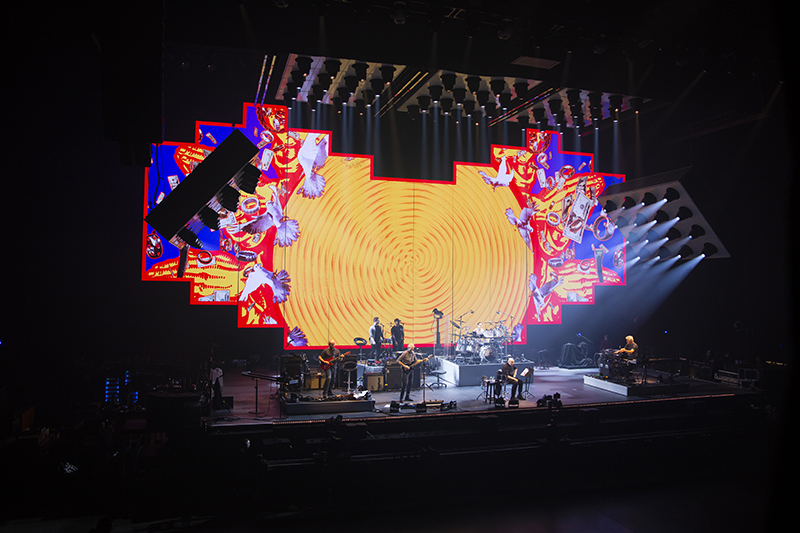
Against All Odds
With the effects of the pandemic continuing to darken doors, Genesis’ team found ways to ensure that they could all work safely within social restrictions. In October 2020, after Marc Brunkhardt began programming lights in Neg Earth’s London warehouse, the rest of the crew relocated to the vendor’s LH2 complex for four weeks of production rehearsals. Says Greil, “Once the band was ready, we began a strict regime of having them perform one run-through, and then Mike and Tony would join us to review the show. Their input amounted to a genuine collaboration.”
Just prior to the rehearsal phase, as a result of tighter restrictions and fears over increased risks of infection, the tour—due to open on Nov. 16, 2020—had to be postponed. Says Greil, “Nevertheless, everyone was thrilled to be back in the thick of the action, even though we were just rehearsing. It was almost another year before we could pick up from where we’d left off.” Set to restart the following April, the tour eventually made its debut in Birmingham, UK on Sept. 20, 2021, with a North American leg kicking off in Chicago in mid-November, and UK dates set for March 2022.
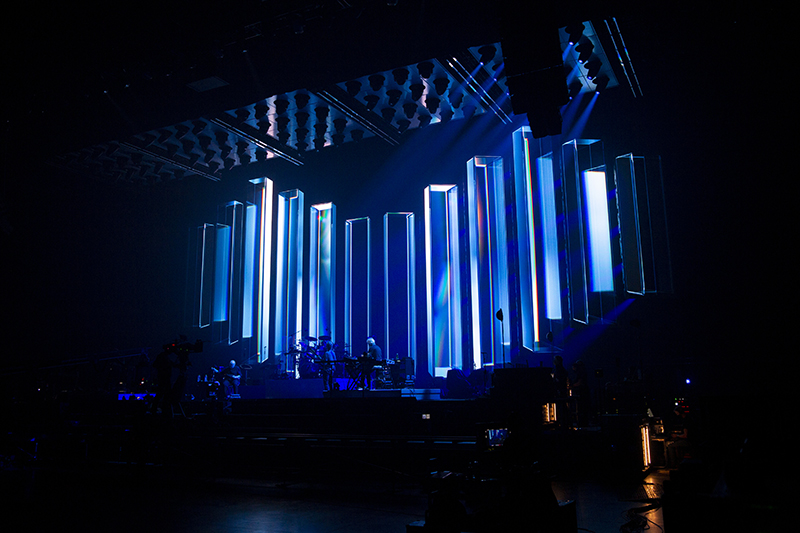
Dominoes & Fixture Choices
WBD crafted a genuine 21st century show in which to frame the band’s legacy. When Woodroffe conjured the idea of featuring five fully motion-controlled lighting pods, it wasn’t a huge leap to imagine them as giant dominoes, each of them containing 16 Claypaky Scenius Unico spot/wash heads and independently controlled. Manufactured in Belgium by WIcreations, the pods’ structural elements are fully clad with medium gray aluminum composite sheeting, lined with a grid of TMB FloppyFlex LED tape that presents yet another dimension to the set in the latter portion of the show. Each strip can separately dim, flash, or fuse in wild bursts of color. Sending out PosiStageNet (PSN) protocol, the MA2 desk captures the exact position of the pods during its tilting movement and allows them to adjust instantly and maintain their focus.
Greil notes, “In ‘Second Home by the Sea,’ for example, there’s a powerful, almost psychedelic scene in which the pods move as one. The visuals then change completely in a way that the audience aren’t expecting and it’s a huge ‘wow’ moment.”
Across the full stage depth, between each pod, is a straight FX truss carrying two rows of automated GLP X4 Bar 20s. These battens are also rigged on the video truss to create depth by lighting the back wall. The X4s are mostly used during the ‘80s numbers, although for ‘70s prog staple “Firth of Fifth,” the song is exclusively lit by X4s to create light curtains that move and change color.
Eighteen Robe BMFLs are the workhorses for key lighting the band. Says Greil, “We have 12 of them on the advance front truss and three each side in traditional followspot positions to help make the band pop out on stage.” While 24 SGM P-2 wash units uplight the band members from the floor, an arrangement of upstage P-10s shoot upward from behind the backline and work in tandem with a bank of smoke machines to reproduce a classic glow effect for the song, “Afterglow.”
Further floor lighting comes from 18 Claypaky Mythos hybrid fixtures—creating silhouettes and providing different layers of beams—and Solaris T-Light strobes, chosen for the high-powered (85kW) strobe effects dominant on “Domino.” Instead of traditional Moles for audience lighting, Greil is cueing Solaris Flare Q+ LED flash/floods. He explains, “They’re not as warm as the older technology but they do give you the opportunity to do more than you previously could, such as turn the whole arena into a deep saturated color, create some chase effects, and much more. We also have an additional 40 Unico fixtures positioned on the audience truss to help conjure an immersive arena experience.”
The Last Domino? is one of the latest tours to deploy Follow-Me, the Art-Net based calibration software package that uses moving lights as followspots. A safer, more economical alternative to traditional followspot usage, Follow-Me also solves weight issues where operators and truss seats are too heavy or hard to implement. “We’ve used Follow-Me on a variety of shows and tours, the first being Rammstein when we had the system controlling around 500 moving lights,” Greil explains. “As long as you can use a computer mouse and follow a target crosshair, you can operate it. It offers so much more flexibility.”
Naturally, Vari-Lite products have a place on the tour, as Greil explains. “The VL6000 fixtures are unique in their own right. As far as I’m aware, it’s the only beam fixture with a big diameter lens that can give you a searchlight look. These are hidden in the mother grid and are used with the Follow-Me system for backlighting the musicians and placing them in shafts of light. We also have the fantastic VL6500 wash fixture on the deck and also upstage on a shelf for strong floor looks. Together with the 6Ks, they give us two levels of a certain kind of ambience that most probably only Vari-Lite can deliver.”
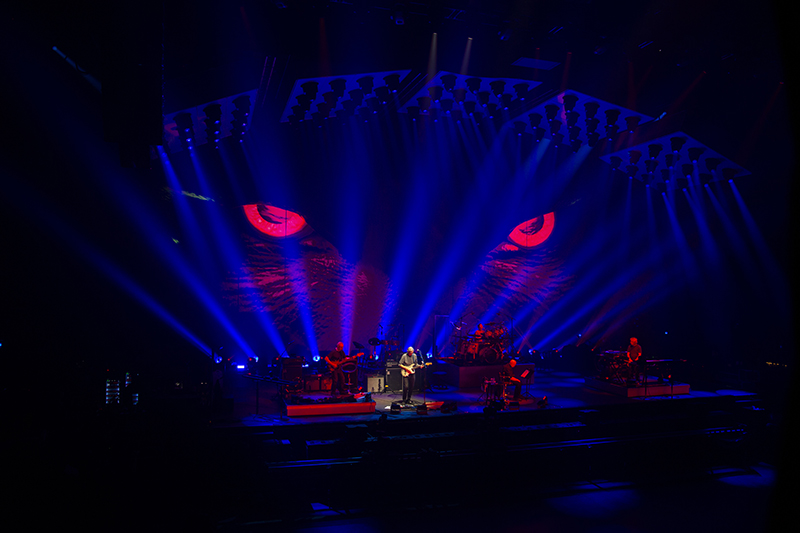
Video Backdrop
Anna Valley Touring is providing Genesis with LED displays and I-Mag services, working alongside WIcreations, whose automated rigging know-how is at the heart of the impressive backdrop. It relies on a 36m (118’) long truss with 12 tracker dollies and 12 rotators as the base rig for 12 rotating and horizontally shifting Anna Valley AVX3 Unilumin 3.9mm pixel pitch panels. Totaling 208m2 (682 sq. ft.) and offering a full width resolution of 8,960px x 2,816px, these structures range between 6m (20’) and 10m (32’) in height.
WIcreations incorporated the screen into a custom frame system, providing a tracking video wall that turns and splits into several permutations of columns. (Besides motion control, WIcreations’ team also created a new, patented stage flooring system together with five complementary custom rolling risers.) Jeremy Lloyd, of Wonder Works, offered the suggestion of tracking to allow the screen modules to close up completely and create larger, more versatile surfaces for video as well as different shapes. “It’s amazing how many genuinely different looks have been generated through this design,” Lloyd comments. “There seem to be never-ending changes in mood and dynamics. Lighting and video have rarely shared such a partnership.” In addition, Planar CarbonLight CLM6.9 Series mesh LED displays were sub-rented from Universal Pixels as portrait side I-Mag screens, chosen for their light weight.
Another veteran from the 2007 tour, Ruary Macphie is involved this time as video project manager, a role allied to his current position as head of Anna Valley Touring. Macphie, who began the tour as the camera director and returned later as an LED/camera technician, comments, “Weight loading was a massive consideration for rigging… the biggest priority when specifying equipment.”
Dynamics By Degree
One of the biggest “gags” of the show emerges for the song “Fading Light,” when the upstage video screen is split into 12 vertical panels that rotate 180° to reveal a wall populated by 64 of Ayrton’s ultra-compact Karif LT 300W beam-spot luminaires. Notable for their extraordinarily bright long throw and zoom ratio of 17:1, the Karifs number between four and six per panel.
Greil explains: “We were searching for a very bright fixture that was extremely light in weight, so that it placed minimal extra burden on the truss, which was already supporting 26 tons. Our friends at Ambersphere showed us this new Karif fixture which weighed just 27kg and we were immediately convinced that it was the perfect tool.”

Filling The Canvas
The vast screen canvas is home to a bewildering array of video content commissioned from Treatment Studio. The creative agency was founded by industry pioneers Sam Pattinson and Willie Williams, the former taking the lead on content design and production for Genesis with Giles Maunsell. Along with content creative director Noah Campeau, they discussed some of their personal show highlights.
Inspired by the Lebanon War of the early ‘80s, Tony Banks set the lyrical action of “Domino” in a Beirut hotel room as bombs began to fall on the Lebanese capital that, on-screen, is represented by a vast landscape of dominoes. Like the two-part song itself, the content follows a journey of a cataclysmic domino effect that ends in a graveyard of toppling structures. Says Campeau, “Tony was keen to keep tabs on how we were developing it with its modernized feel. This was a narrative-led piece—a journey through evolving environments, following the energy and music arc—and perfect cueing was essential. Getting that final domino to fall on the last beat of the song was always a challenge, so it was probably one of the most heavily rehearsed numbers.”
Coming in the middle of a pandemic, this posed a challenge for Treatment’s creative heads who, under normal circumstances, would have been based at their south London office. “Coordinating with our team, we had to adapt accordingly,” says Campeau. “As the project moved forward and they were working remotely on ‘Domino,’ we were editing the 6K content, rendering and pulling everything together on-site at LH2. It was all very intense.”
Eighties hit “Land of Confusion” provides an opportunity to lampoon the often awkward bureaucratic responses to the pandemic. Pattinson explains, “Things had become so ridiculous that they were hard to ignore. So, you see toilet rolls raining down on empty streets during lockdown and marching armies of city types wearing masks and walking into the countryside. They’re all discreet acknowledgements of certain events or individuals, and the audience response has been fantastic every night.” Visually retrospective, “Throwing It All Away” was previously the vehicle for a montage of old media and memorabilia, but as Maunsell states, the ability to split the video screen into columns on this occasion lent itself to showcasing a library of the band’s cassette spines. He adds, “The screens are of such a high resolution that we were able to build huge cinematic landscapes in ‘Home by the Sea’ and cityscapes for ‘Land of Confusion,’ and not detect any pixelation, so placing the band onstage within these scenic environments was incredibly effective.”
Three disguise VX4 media servers were chosen to deliver the required amount of video sources. Operated by Ellie Clement in tandem with another grandMA2 desk, the servers are programmed by Ray Gwilliams while Xander Ballet from WIcreations shares the same space in which to run the automation. “We are all working from the same show file with no time code,” claims Greil. “It’s all manually controlled, and that’s important, because you’re dealing with a very live band, steeped in history, so taking an analog approach is appropriate. We’ll get slight variations every night. I believe that if you can run a show completely live, you really should because that’s the nature of the music itself, otherwise it can feel clinical. With lighting and video integrated in the same control world, it offers the opportunity to link up specific cues. If you want to wash the stage in red and also have the video screen turn red, it’s one button push.”
Macphie liaised with Stuart Merser of camera company Vis-A-Vis Video on the design of an I-Mag capture solution that is almost entirely remotely operated and captures dynamic footage in an unobtrusive manner. This element of the visual production was designed around Blackcam’s remote systems using four Blackmagic Design URSA Broadcast cameras, and the addition of telescopic capabilities, tracking Towercams and a Canon UJ90 long lens allow for intimate shots without impeding the audience view. A custom design in the pit uses laser programming that enables two Blackmagic cameras to share one length of track and, therefore, maximize audience seating.
By also employing discreet cameras on Blackcam remote dollies with rails, it was possible to achieve a range of unusual views. Says Macphie, “This allowed us to dispense with any hand-held cameras. Although this wasn’t a move dictated by Covid protocols, it unwittingly solved that problem while getting some unique shots of the band and their interaction. Picking up some truly great shots of Tony Banks at his keyboards was a godsend, thanks to having Camera Corps’ Qx robotic ball heads on a pair of B10 dollies that could be operated by one person.”
Fade To Black
Although Tony Banks insisted on placing a teasing question mark after the tour title—The Last Domino?—it is understood that this tour will be Genesis’ last, and will continue for as long as Phil Collins feels able to travel and perform, and this will not be for long. Greil summed up his reluctant acceptance of the inevitable. “The most profound moment in the show for me is when Phil, Mike, and Tony perform ‘Fading Light,’ which features a very simple, theatrical lighting state. It’s given me goosebumps every night because it’s like they are saying goodbye. Sadly, this seems to be the case, but I feel so honored to be a part of this incredible band’s swan song.”
Photos courtesy of Treatment Studio.
Online Extra –
Behind the Story: Witnessing a Revolution
While on vacation in Spain during September 1981, writer Mark Cunningham witnessed the very first live show to feature Vari-Lite automated light technology.
Cunningham tells the story: “The concierge at my hotel in Barcelona recognized that I was a big music fan. (I was always wearing band T-shirts back then, but I think real giveaway was that I was carrying a pass-covered guitar case when I checked in at the hotel!) He asked if I’d be interested in buying a pair of tickets for a Genesis show the following evening, as he couldn’t make it. I had seen the band multiple times since early 1977 and was planning to catch them later on their new Abacab tour, but this was the opening date and I couldn’t refuse.”
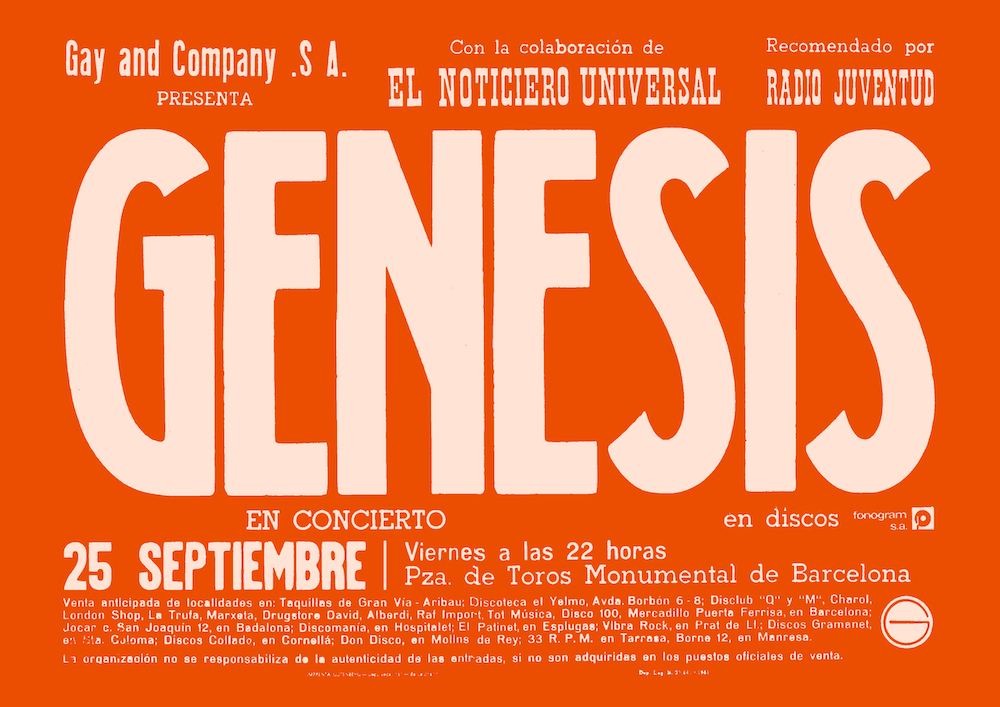
Cunningham continues: “I arrived at the Plaza de Toros Monumental oblivious to the band’s investment in a revolutionary lighting fixture so there wasn’t a great sense of occasion attached to this gig, other than I was a huge lover of the music, but there was something different about the production. The visual dynamics were more profound and the stage saturated in the most vivid color I’d ever seen. I was soon made aware that I’d watched a demonstration of the first Vari-Lite Series 100 [VL1] system, meaning that Designer Alan Owen and Programmer/Operator Tom Littrell finally had complete control over every variable parameter of light, from color, pan and tilt, to beam size and patterns. A new age for concert production dawned that very day and it wasn’t until many years later that I fully grasped how fortunate I was to have seen it unfold.”
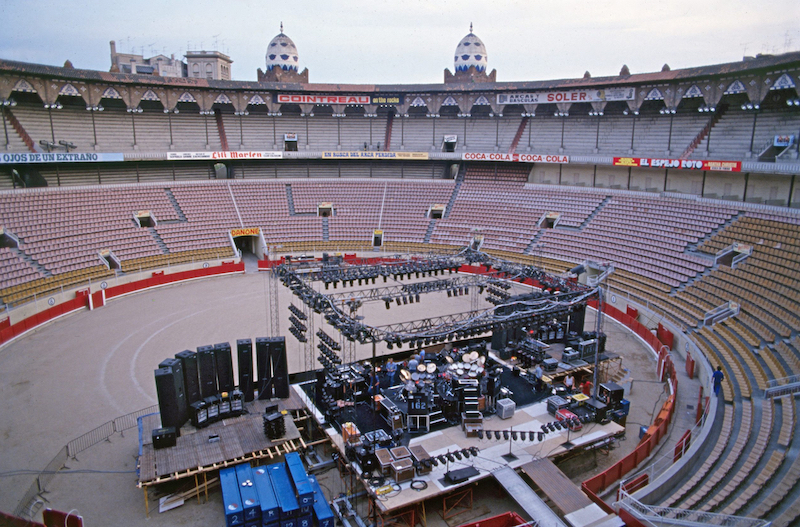
Genesis have continued to play a key role in the development of production and, thanks to their original vision and commitment to driving the art forward, we now live in an era where moving light technology can be found everywhere, even in the smallest of venues.
Naturally, Vari-Lite products have a place on The Last Domino?, as Roland Greil explains, “The VL6000 fixtures are unique in their own right. As far as I’m aware, it’s the only beam fixture with a big diameter lens that can give you a searchlight look. These are hidden in the mother grid and are used with the Follow-Me system for backlighting the musicians, and placing them in shafts of light. We also have the fantastic VL6500 wash fixture on the deck and also upstage on a shelf for strong floor looks. Together with the 6Ks, they give us two levels of a certain kind of ambience that most probably only Vari-Lite can deliver.”
U.K.-based freelance writer/editor Mark Cunningham can be reached at https://groovehype.uk
Genesis The Last Domino? Tour
Crew
- Show Director/Creative Director: Patrick Woodroffe/Woodroffe Bassett Design
- Co-Lighting Designers: Roland Greil & Patrick Woodroffe/Woodroffe Bassett Design
- Content Design and Production: Treatment/Sam Pattinson & Giles Maunsell
- Technical Integration and Design: Jeremy Lloyd/Wonder Works
- Lighting Director: Roland Greil
- Lighting Programmer: Marc Brunkhardt
- Video Director: Darren Montague
- Video Programmer: Joshua Key
- disguise Operator: Ellie Clement
- Automation Operator: Xander Ballet
- Lighting Crew Chief: Luke YC Radin
- Lighting Crew: Matt Flood, Andy HED Thompson, Barry Banford, Dan Wiseman, Bianca Mastorianni, Neil Johnson, Tom Bailey, Jim Mills
- Production Manager: Howard Hopkins
- Tour Manager: Steve “Pud” Jones
- Stage Manager: Ian “Robbo” Robertson
- Head Rigger: Steve Armstrong
- Head Carpenter: Chris Organ
- Lighting Vendor: Neg Earth
- Automation, Set, and Staging Vendor: WIcreations
- Video Vendor: Anna Valley Touring
Gear
Lighting:
- 2 MA Lighting grandMA2 full-size Console
- 2 MA Lighting grandMA2 light Console
- 148 Claypaky Scenius Unico
- 18 Claypaky Mythos 2
- 18 Robe BMFL Spot
- 14 Vari-Lite VL6500 Wash
- 10 Vari-Lite VL6000 Beam
- 64 Ayrton Karif-LT
- 123 GLP impression X4 Bar 20
- 28 SGM P-2 Wash Light
- 18 SGM P-10 Wash Light
- 81 TMB Solaris Flare Q+ Strobe
- 3 TMB Solaris T-Light Strobe
- 1 TMB Floppy Flex RGBW LED Tape Setup
- 1 Follow-Me Remote Followspot System
Atmosphere:
- 5 MDG theONE Atmospheric Generator
- 10 Look Solutions Viper NT
- 5 Martin JEM AF2 Fan
Video:
- 12 Anna Valley AVX3 Unilumin 3.9mm Pixel Pitch Panels
- Planar CarbonLight CLM6.9 Series Mesh LED Displays
- 3 disguise VX4 Media Servers
- 4 Blackmagic URSA Broadcast Cameras
- Canon UJ90 Long Lens
- Blackcam Remote Dollies with Rails
- 2 Camera Corps Qx Robotic Ball Heads
